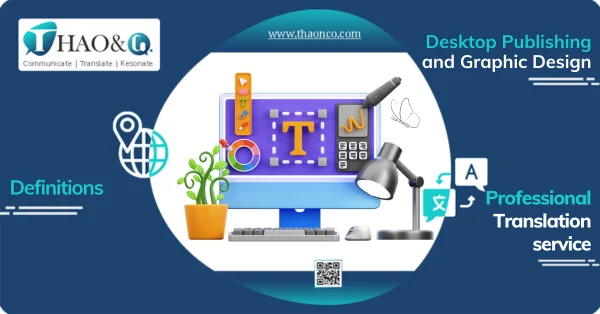Desktop publishing and graphic design are both common terms, but how are they different from each other? Join Thao & co. as we unravel the differences between these two terms and explore how they make their marks in the creative and translation industries, from the technology to the work processes and the final products.
Desktop Publishing or DTP involves the use of computers and specialized design software to create text and graphic materials, such as magazines, books, reports, leaflets, etc.
Graphic design is the process of conveying ideas and messages through pictures, texts, and other visual elements.
In the translation industry, desktop publishing and graphic design play crucial roles in producing high-quality texts and visuals for a wide range of materials, including books, packaging, magazines, brochures, and promotional materials to satisfy clients’ requirements.
Professionals in these fields possess design thinking skills, expertise in specialized software, and knowledge of layout, text format, and color theories to effectively convey messages and captivate viewers. These processes are vital in translating and localizing materials with complex designs.
By combining translation and design, DPT or graphic designs create products that are both linguistically appropriate and visually appealing, thus increasing the communication values of your materials to the global audience.

Generally, desktop publishing focuses on polishing technical aspects, while graphic design enhances visual elements.
In desktop publishing, DPT specialists must ensure that page alignment and text formatting are done correctly to optimize document layout for reading and printing.
On the other hand, graphic designers must channel their creativity to produce print or digital designs that appeal to a specific group and convey messages effectively.
Desktop publishing requires the utilization of programs such as Adobe InDesign and QuarkXPress to build layouts and format texts. Meanwhile, in graphic design, software like Adobe Photoshop and Illustrator is indispensable for creating and editing visual materials.
Attention to detail and meticulousness in organizing and formatting texts are essential qualities for a DTP specialist. In addition, they also need to have basic knowledge of printing. In contrast, graphic designers must have a sense of artistry to visualize shapes, colors, and proportions, along with expertise in design techniques.
While desktop publishing emphasizes layout optimization and precision, graphic design requires creativity to produce unique and eye-catching visuals, especially in adapting materials to various cultures and languages.
Desktop publishing is typically applied to standardized materials such as books, newspapers, user manuals, reports, and technical documents. Conversely, graphic design is vital in fields like marketing and advertising or branding, where visual appeals and creativity are called for.
Desktop publishing translation entails formatting translated texts to maintain the original layout. Meanwhile, graphic design is used for creating visual elements such as graphs, images, and fonts for the translations.
Both desktop publishing and graphic design are flexibly utilized in translation projects, depending on the purpose and budget of the client. Each method has its own advantages and tends to different needs in conveying messages via texts and graphics.
Desktop publishing is an essential process in professional translation to adapt translated content to match the original layout. This process is particularly important for materials with many pages such as books or reports, and other materials with strict formatting rules.
Therefore, it is best to entrust your materials to a translation agency with extensive experience in desktop publishing to improve the quality of translated materials, particularly when layouts and graphic information like graphs or tables must be maintained.
Graphic design is crucial in conveying messages through visual elements such as banners, posters, backdrops, brochures, social media images, and so on.
This process requires the translator and designer to work together to create visually appealing materials appropriate to the target culture and language while sticking to the marketing strategy of the business.
In the multilingual setting, the selection of a translation agency depends on their ability to provide not just an accurate translation, but also to preserve the aesthetic quality of the final product to meet diverse needs.
At Thao & Co., we always strive to achieve a perfect balance between top-notch translation and visually appealing materials. We understand that DTP and graphic design play critical roles in transferring the original message effectively.
Are you looking for a translation company for the following materials?
Let Thao & Co. be your partner, helping elevate your brand’s image and showcase your professionalism through our top-notch text and document translation services.
Whether dealing with print or digital materials, we approach every project with the highest level of precision, delivering premium-quality translations that cater to all your requirements.

Our team of expert linguists and seasoned designers will bring you translations that are both linguistically accurate and visually appealing, supporting your success in the global market.
Contact Thao & Co. via the Get a Quote page right now to experience the difference and bring your materials to the next level!